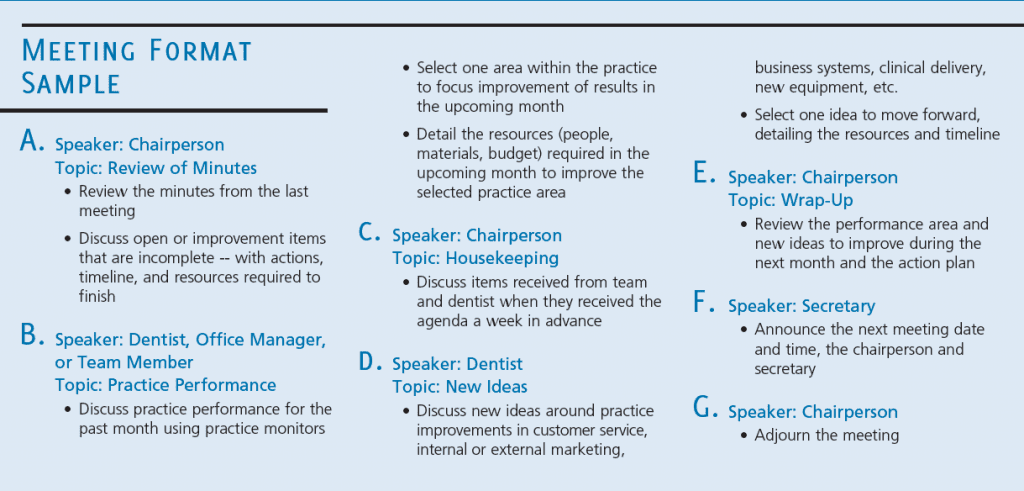Originally published in 2012
If you are like so many business owners, you dread monthly team meetings. Although your rational mind acknowledges meetings as necessary, the little voice in your head keeps whispering, “They are such a waste of time and I really do not enjoy them.” Truth is, team meetings are an integral part of creating a harmonious working environment by opening communication. They provide the time and place to share ideas, formulate improvement plans, and celebrate achievements.
We know firsthand how valuable team input is in improving the practice, fulfilling job descriptions, and improving team morale.
As consultants, we send confidential information packets for team members to complete prior to a consulting engagement, as well as interview team members when we are on-site. Our management approach involves the entire team and seeks to address “what’s in it for them” when they participate in practice enhancement.
One of the most common concerns reported during our team interviews is the lack of communication. Team members often cite a lack of communication around the general transmission of practice news, scheduling changes, or simply being made aware of meetings. Team members comment that while some team members may be in the know via memos or conversation, the practice does not have an effective and efficient method of keeping everyone in the loop.
Team meetings can serve as one method to improve communication within the practice. Meetings can provide the forum to get the word out regarding practice enhancement changes, vacation time, new routines, or other information of importance to all team members. If meetings are to be used to improve communication, getting the right formula for successful and productive meetings is essential.
STEP 1:
The first step to planning productive meetings is to set aside time monthly in the schedule for the year. If some staff are part-time, vary the day and time of day of the meetings to allow all employees an opportunity to participate.
STEP 2:
Determine how the meetings will be organized and the expected outcomes. Establish a consistent format, length of time, chairperson, and secretary (along with deciding if the chair and secretary should change monthly) to form the basis of the planning phase. Use a consistent meeting format every month and distribute the agenda to the team and dentist one week before the meeting via office memo or email. This will afford everyone an opportunity to prepare for the meeting or suggest items to be considered in the new ideas or housekeeping segments of the meeting.

Set aside one and a half hours at a minimum. If the meeting is at lunch, eat first before proceeding with the meeting.
The chairperson is responsible for keeping the meeting moving to ensure all agenda items are discussed. If there is a long discussion pertaining to a specific area within the practice, a department meeting is scheduled.
The secretary records the meeting and prepares the minutes. Minutes are forwarded to all within one week of the team meeting. Minutes are included in the office minutes book or software file.
STEP 3:
Schedule departmental meetings when discussions are centered around a specific aspect of the practice, such as clinical assistants, hygienists, business personnel, or associate dentists. This prevents the general team meeting from getting bogged down with challenges or ideas pertaining to one area.
STEP 4:
Create an environment of safety, i.e. safety from feeling embarrassed when bringing forward an idea or suggestion. Show respect for people’s ideas by acknowledging their ideas whether they are adopted or not. Ensure there will be no retaliation when a team member voices an opinion and it differs from the majority. (This step sounds like common sense but for many team members who confide in us, the reality is they feel they cannot voice their ideas at meetings.)
At the next meeting listen carefully to those who are speaking and pay attention to those who are not. Is the culture and spirit of the meetings creating an environment where all team members are comfortable participating?
In closing, I urge dental professionals to begin the process of improving monthly team meetings by implementing these four basic steps for productive and lively meetings. Turn the dreaded team meeting into a forum where common ideas and goals are expressed and victories celebrated. Build on the success of your practice by opening lines of communications with your biggest asset: Team!

Dale is CEO of Tucci Management Consultant Incorporated in Ontario, CN. You can connect with her on LinkedIn.

